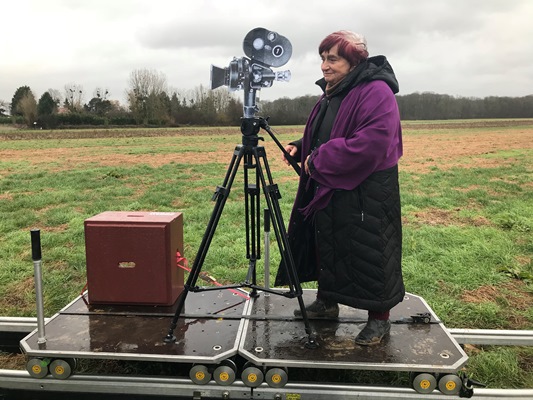
As distinctive as her customary purple outfits, the work of Agnès Varda captures a singular vision and an independent spirit. In the highly illuminating Varda by Agnès, the pioneering filmmaker guides us through the chapters of her working life and discusses and the backstories of key films and visual art. Varda passed away in March at age 90, just after this career-highlighting documentary premiered at the Berlin International Film Festival.
Screened in France as a two-episode TV series, Varda by Agnès is jam-packed with words of wisdom from the prolific writer/director and is a full meal in one sitting. It combines excerpts from speaking events, film clips, live footage, and reconstructions. The first hour concentrates on her movies—albeit non-chronologically—such as La Pointe Courte (1954), which launched her as one of the originators of the French New Wave along with François Truffaut and Jean-Luc Godard. The second hour takes a deep dive into her still photography and installations, which may be new to those familiar with her films.
Born in Belgium to a Greek father and French mother, Varda studied photography and art history at the’École du Louvre, and her film skills were self-taught. Fame and attention peaked in recent years, perhaps as historians correct gender imbalances by bringing attention to female filmmakers unjustly overlooked or marginalized in the film canon. To wit, her penultimate film, Faces Places (2017), garnered her an Oscar nomination, and she became the oldest person ever to be nominated in a competitive category. The official poster for the 2019 Cannes Film Festival featured Varda shooting La Pointe Courte in one of many tributes and honors bestowed on the director of late.
“There are three words that are important to me: inspiration, creation, and sharing,” says Varda in clear French as she holds court to a crowd of cineastes in an opera house. What comes next is a virtual master class as she breaks down the elements of her three-part approach. She reflects on her early oeuvre, such as Cléo from 5 to 7 (1962), a real-time countdown in the hours before a woman is to learn from her doctor if she has cancer, and Le Bonheur (1965), about how a happy family handles an extramarital affair. Her work often focused on women’s stories, including One Sings, the Other Doesn’t (1977), a seminal film set in the early feminist movement. In some of her fictional stories, Varda included members of her community, such as the local villagers, the baker, and the hairdresser. In others, she cast her young son and daughter.
Varda created a portrait of her husband, filmmaker Jacques Demy, just before he died. Jacquot de Nantes (1991) relays his youth in an auto shop and his fascination with filmmaking elements—lighting, set design, and animation. His film The Umbrellas of Cherbourg (1964) garnered the couple an invitation to Hollywood, and it was there that she later partially filmed the comedy One Hundred and One Nights (1995), a commercial flop despite a star-studded cast that included Marcello Mastroianni, Catherine Deneuve, and Robert De Niro in an amazing turn, speaking phonetic French.
An experimental director, Varda worked in both fiction and nonfiction, sometimes combining the two in a hybrid such as The Beaches of Agnès (2008), a memoir focused on her love of the sea, with hilarious scenes of her “offices” constructed outdoors on sand covered streets. With the onset of digital filmmaking, her diminutive size and small camera made her particularly approachable as she spontaneously documented regular folk, such as the gatherers of leftover food in The Gleaners & I (2001). “They eat what we throw away,” she says, explaining that those words of resourcefulness and recycling guide her life.
Varda’s installation work makes use of this philosophy and is just as intriguing as her films. In A Cinema Shack: The Greenhouse of Happiness in Paris (2018), she stacked film canisters to create an archway and hung 35mm filmstrips as ersatz beaded curtains for the “shack.” An installation about eviction included a soiled mattress and old TV set. A constructed grave for Varda’s cat, Zgougou, turned the concept of a subdued burial chamber into a colorful celebration with flowers and seashells. Just as enlightening are Varda’s series of photo portraits over the course of her life, featuring well-known figures in the arts: Federico Fellini, Alexander Calder, and Eugène Ionesco.
Varda by Agnès brings valuable insights to a significant career, one that is remarkably front and center in the discourse, more than six decades after it began.
















Leave A Comment